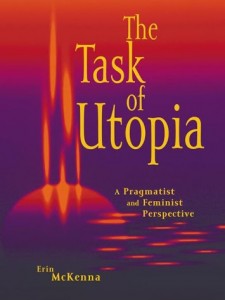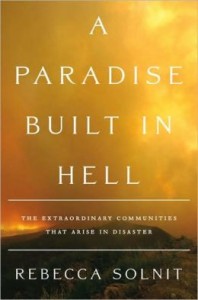“They taught us at Barnard about that word, ‘utopia’. The Greeks had two meanings for it: eu-topos, meaning the good place, and u-topos, meaning the place that cannot be.”
—Rachel Menken, Mad Men (S01/E06 “Babylon”)
Everyone has a favorite dystopian novel or series lately. From classics like Brave New World, 1984, or Fahrenheit 451, to more modern takes by Margaret Atwood, P.D. James, or contemporary authors Kazuo Ichiguro and Suzanne Collins, we are far from spoiled for choice when it comes to the post-apocalyptic adventure story of individuals triumphing over oppressive regimes. For me, it barely requires me to even leave my neighborhood to find stories like these—my local bookstore has a Post-Apocalyptic Book Club that meets every month to discuss a new dystopian tale!
But not many of us can think of great works of utopian literature outside of a small list of classic—much less popular—pieces by authors who have also written about dystopian worlds. Many of us know Kurt Vonnegut, but not for his technological utopia Piano Player. And for the more feminist reader, they will be well familiar with Charlotte Perkins Gilman’s “The Yellow Wallpaper,” but probably not Herland. While reading up on this piece, I even took a cursory look at lists of dystopian and utopian novels on Wikipedia, just to compare. Unsurprisingly, the dystopian list was much longer and more consistent over time.
I’ve often wondered why it is so difficult for us to find something worthwhile in the idea of utopia. It’s become a common trope to think about heaven as a dull place, and a cliché to set up one of our most recognizable real-life utopian experiments—the hippie commune—as a recipe for corruption, disillusionment, and failure. And you don’t have to go far into reading about World War II or the Cold War to figure out that they, too, were born out of utopian end-states that we now recognize as terrifying experiments in social engineering. By these accounts, it doesn’t appear to be in our nature as humans to make our social fantasies sustainable—or even agree on what those fantasies are. We’re prone to squabbling, categorizing, getting high on power, and often times, committing horrific atrocities to realize our visions… all things that make for trouble in paradise.
No one could live like that forever, which may be the point. Do we really understand what utopias are, and what purpose they can serve us?
I once felt that utopias were a dangerous idea, too, and have had my own rich relationship with post-apocalyptic dystopian fiction, from Lois Lowry’s The Giver and Gathering Blue as a child, to Margaret Atwood’s The Handmaid’s Tale in high school, and Emily St John Mandel’s Station Eleven as an adult. But I think this is the chief misunderstanding of utopia as a concept, one that I think many people overlook in writing it, and certainly when they go to malign it. As a reader, I have certainly struggled not only to find as much utopian literature, but also to enjoy it as thoroughly as I want to. So much of it seems to suffer from the same pitfalls, be it believability of the world and its characters, or the world’s fragility against the influence of outsiders. I often found these issues frustrating and unsatisfying, and so here is where I admit that, as much as I believe in the need for utopia in literature, I am guilty of avoiding stories depicting them—and where I haven’t avoided them, I wasn’t as interested in them. There is a hollowness to ready-made utopias that makes it hard to root for them, and until recently, I figured it was mainly a ringing truism that utopias just aren’t compelling. But I’ve started to realize that there can never be a utopian world in the way there is a dystopian world, because effective utopias don’t live in a bell jar, static and perpetual.
 Erin McKenna wrote in her seminal work The Task of Utopia that one reason literary utopias get such a bad rap is because they depict what she calls an “end-state” utopian society. We’re familiar with these utopian societies because they’re the only ones we really ever see. Such societies are incredibly difficult to maintain, so much so that they often require dully conformist (at best) or brutal (at worst) means to keep the status quo. It ends up bringing to mind other failed utopian experiments throughout history, reinforcing the common argument that a perfect world cannot exist—and that any claim of one is suspect. The baby is thrown out with the bathwater, and we retreat into a grim sort of cynicism. Human nature is innately dark, and any attempts to reform it can only end in disaster. But McKenna also points out that this is not the only way one can imagine utopia—and there are some who have gone another way. Utopia need not be a fragile, static universe, hanging on by a thread; it can also be a world where the utopia is not in the material reality, but in the way its inhabitants relate to each other and solve problems.
Erin McKenna wrote in her seminal work The Task of Utopia that one reason literary utopias get such a bad rap is because they depict what she calls an “end-state” utopian society. We’re familiar with these utopian societies because they’re the only ones we really ever see. Such societies are incredibly difficult to maintain, so much so that they often require dully conformist (at best) or brutal (at worst) means to keep the status quo. It ends up bringing to mind other failed utopian experiments throughout history, reinforcing the common argument that a perfect world cannot exist—and that any claim of one is suspect. The baby is thrown out with the bathwater, and we retreat into a grim sort of cynicism. Human nature is innately dark, and any attempts to reform it can only end in disaster. But McKenna also points out that this is not the only way one can imagine utopia—and there are some who have gone another way. Utopia need not be a fragile, static universe, hanging on by a thread; it can also be a world where the utopia is not in the material reality, but in the way its inhabitants relate to each other and solve problems.
In part out of my own frustrations with the genre, I have been struggling to realize a utopian vision of my own, in a speculative fiction work that engages the issues of our time—notably, climate change, inequality, and disability—but doesn’t assume to slap a Band-Aid on them and be done with it. This vision is a more dynamic and improvisational one, where living beings are guided by an ethically utopian framework that still has to contend with every day struggles of personal egos, natural disasters, illness and aging, and family strife. Oscar Wilde once said, “A map of the world that does not include Utopia is not worth even glancing at, for it leaves out the one country at which Humanity is always landing. And when Humanity lands there, it looks out, and, seeing a better country, sets sail. Progress is the realisation of Utopias.” Wilde here is alluding to something more ephemeral—utopia as process—which sounds all well and good. But is any of this possible, really? Given our largely impotent landscape of utopian worlds, where can we look to even know if this can happen?
I’ve been very inspired lately by a book by Rebecca Solnit (who you might know from  her amazing “Men Explain Things to Me”) called A Paradise Built In Hell. In the book, Solnit argues that disasters have a funny way, given certain conditions, and contrary to popular narratives of disasters’ aftermaths, of creating temporary “disaster utopias.” When the institutions and systems that maintain order in everyday life fail in the wake of extraordinary circumstances, she writes, something magical happens: regular people figure it out for themselves. They come together, they improvise, they act selflessly and communally to solve problems and care for their communities. Hurricane Katrina sparked Solnit’s interest in this subject, in part because of all the ways the massive storm simultaneously provoked cruel suppression and appalling incompetence from the institutions at large, toward those on the ground trying to help, quashing any real hope of swift and peaceful recovery in New Orleans. But in her examination of other great disasters—September 11 in Lower Manhattan, the Great Earthquake of 1906 in San Francisco, the 1985 Earthquakes in Mexico City, and others—Solnit shows how these temporary communities of mutual aid, that typically sprang to life in the immediate wake of the disasters, created spaces that offered people feelings of great meaning and purpose that they had seldom experienced in their quotidian lives. And these communal feelings sometimes coalesced into much larger movements that brought broader and more lasting social changes after the recovery was complete.
her amazing “Men Explain Things to Me”) called A Paradise Built In Hell. In the book, Solnit argues that disasters have a funny way, given certain conditions, and contrary to popular narratives of disasters’ aftermaths, of creating temporary “disaster utopias.” When the institutions and systems that maintain order in everyday life fail in the wake of extraordinary circumstances, she writes, something magical happens: regular people figure it out for themselves. They come together, they improvise, they act selflessly and communally to solve problems and care for their communities. Hurricane Katrina sparked Solnit’s interest in this subject, in part because of all the ways the massive storm simultaneously provoked cruel suppression and appalling incompetence from the institutions at large, toward those on the ground trying to help, quashing any real hope of swift and peaceful recovery in New Orleans. But in her examination of other great disasters—September 11 in Lower Manhattan, the Great Earthquake of 1906 in San Francisco, the 1985 Earthquakes in Mexico City, and others—Solnit shows how these temporary communities of mutual aid, that typically sprang to life in the immediate wake of the disasters, created spaces that offered people feelings of great meaning and purpose that they had seldom experienced in their quotidian lives. And these communal feelings sometimes coalesced into much larger movements that brought broader and more lasting social changes after the recovery was complete.
 Solnit doesn’t limit her criteria of disasters to natural ones, either. Revolutions can breed these kinds of communities. One reading of the Occupy movement in 2011 shows that, while the movement as a consolidated force did not succeed, it did create frameworks that gave birth to new forms of mutual aid we haven’t seen in years. Strike Debt, an organization born out of OWS that still exists today, has helped forgive $31 million in medical and tuition debt in the US. Occupy Sandy, another group that emerged in the aftermath of Superstorm Sandy in 2012, was responsible for organizing more efficient grassroots recovery efforts than FEMA or the Red Cross. These spontaneous communities are seldom codified into policy or formal institutions, but they excel in showing us not only what is needed, but what alternatives are possible. They exist on the margins to invigorate us in times of uncertainty, and provide us with a shore to land on, however temporary, to look out to see what better places we might build. Maybe these are the places we should be looking to as we struggle to imagine utopia and its place in our cultural imagination.
Solnit doesn’t limit her criteria of disasters to natural ones, either. Revolutions can breed these kinds of communities. One reading of the Occupy movement in 2011 shows that, while the movement as a consolidated force did not succeed, it did create frameworks that gave birth to new forms of mutual aid we haven’t seen in years. Strike Debt, an organization born out of OWS that still exists today, has helped forgive $31 million in medical and tuition debt in the US. Occupy Sandy, another group that emerged in the aftermath of Superstorm Sandy in 2012, was responsible for organizing more efficient grassroots recovery efforts than FEMA or the Red Cross. These spontaneous communities are seldom codified into policy or formal institutions, but they excel in showing us not only what is needed, but what alternatives are possible. They exist on the margins to invigorate us in times of uncertainty, and provide us with a shore to land on, however temporary, to look out to see what better places we might build. Maybe these are the places we should be looking to as we struggle to imagine utopia and its place in our cultural imagination.
I think it’s important that we continue to give artists the chance to wrestle with utopia, as they do with dystopia. In many ways, I think it’s a bigger challenge to imagine a utopian world. Our brains are primed to pick out what’s wrong, and it’s tempting—especially in this moment in time when we are living through so much precariousness all around us—to imagine the worst possible outcome. Given the cultural narratives we’ve come to accept as intrinsic to human nature, who could blame us? But our own lives have slowly become scripted in the language and imagery of dystopia: climate change, drone wars, inescapable intrusion on our privacy, financial collapses, hysterical and out of touch governments. Many people think we are already living in dystopia, and maybe we are. But we don’t have to. We just need new maps, and those maps need to show us the way to utopia.
The Task of Utopia and A Paradise Built in Hell cover images via Amazon (1) (2). Occupy Sandy image nynjgoodwill. Featured image via Flavorwire.


